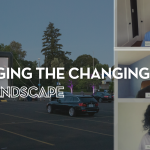Safety Considerations for Fall Planning
DISCLAIMER: All information presented here is offered for your consideration only and should not be utilized as an official safety policy or professional consulting advice. Every organization must do their own risk assessment for returning to in-person events, including doing their own research on their organization’s liability, safety and risk tolerance. We in no way endorse using any information presented here to make your gathering decision. You must do your own safety audit.
The event planning space—like so much of the rest of our lives right now—is dynamic. Dynamic spaces and event planning aren’t an easy match because event planning requires firm dates, contracts and details that the world around us right now is making hard. While duty of care is a social contract that we all participate in daily, its importance is elevated as we try to emerge from a worldwide pandemic. The health risks around COVID-19 and the rapid spread of the Delta variant have heightened the risk for gathering people for our organizations.
Here are some critical safety considerations as you do a risk assessment with your organization and navigate the future of your gatherings.
Risk Assessment
First and foremost, your organization needs to do a deep-dive risk assessment. This means asking your staff and board: What are you willing to risk by holding an in-person gathering and who will be responsible for that follow-up should something happen? The CDC guidelines change constantly and we must remember that they are only guidelines. Currently, they’ve loosened suggestions around mask use in vaccinated populations but as at the time of posting this article they were still NOT recommending large gatherings.
Guest Survey
After the risk assessment, you should survey your potential guests. It does your fundraising no good to throw an event if your guest base isn’t comfortable gathering. Conversely, knowing the circumstances under which your donors would like to gather helps you plan the infrastructure of your event. If the majority are willing to gather with contact tracing, hand sanitizer and masks available, you need to work that into your planning. This process will also likely illuminate for you that have two donors: those willing to attend and those who don’t feel safe to do so. How will you reach both? Is a hybrid event something to consider?
Guest Agreement
If you do move forward with an in-person event, you’ll need to decide about vaccinated vs. unvaccinated guests, how you’ll communicate that and how you will facilitate that onsite. Will contact tracing be a part of your pre-event guest communication or be handled onsite? How will you gather all the information you need to report to local public health officials if multiple people get sick as a result of attending your event? Also think about what your guest agreement is and make that a part of the details of their ticket purchase—not showing up sick to the event, cancellation/refund protocols, etc.
Safety Enforcement
You also need to carefully plan what your safety enforcement protocol will look like. Will you have health screening onsite, what will your contract tracing details be, how will you communicate to guests if you have a vaccine requirement for attendance or not? Within your organization you will need a compliance officer, providing continuity and attention across all agreements, contracts, health + safety protocols, etc. This should be someone different than the project manager on your event to institute checks and balances. Also, you’ll need to decide as an organization what the plan is should something happen at your event. Who is responsible for what in your response, what does your reporting protocol look like, what does your crisis communication plan look like?
Venue Planning
Your venue is your biggest first step for an in-person gathering. There are several things you should consider before signing a contract:
- What kind of venue is it: outdoor/indoor, moveable walls, bathrooms, ceiling height, number of entries/exits to the room, increased space for registration
- What does COVID-compliant seating capacity look like: individual table capacity, table spacing in the room, maximum number of guests in the space by local/regional/state COVID rules
- Status of the HVAC system on site: when was it updated, how many other spaces is it connected to and drawing in from, filtration technology
- What are your catering options: table service/service in place, bar spacing, ability to bring in outside providers, safety regulations for food preparation
- What are the venue guidelines: process for CDC-recommended cleaning between events, requirements for outside vendors in the space, vaccination requirements for their onsite staff, cancellation policies, food and beverage minimum costs should your audience size shrink
When you’ve started to factor in those elements, how will they impact the capacity of your room? And then by extension how will a smaller room of guests impact the net of your event?
Planning Needs
Additional considerations as you start to weigh the pros and cons of in-person gatherings:
- Safety protocols and the added expense
- Need of additional volunteers/staff to support additional safety protocols
- How to keep your staff + volunteers safe onsite
- Refund/cancellation policy for all vendor contracts
- Who is in the room (some sponsors are still not sending employees to in-person events until 2022)
This may feel overwhelming, but what if this was actually a time to get really clear on the purpose events serve our organizations and what sort of experience we want to create for donors. Those may dictate a different sort of event. But in all cases, this is a great opportunity for you to sit as a whole organization—staff and board—and talk about how events serve your work and how you’re all going to move forward together helping each other navigate the safety of your guests and your organization as the landscape continues to evolve.
Here are some resource links for you to utilize when considering returning to in-person gatherings. In the end, you need to create a plan that puts both the safety of your guests and your fundraising first. Neither happens without the other.






